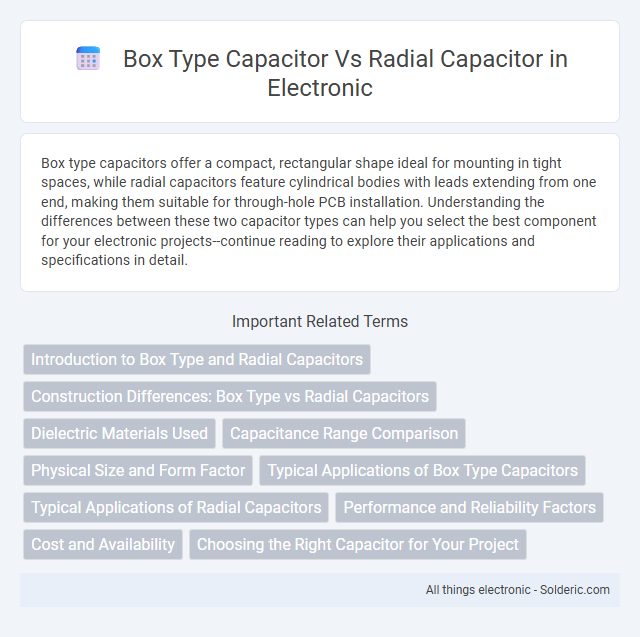Box type capacitors offer a compact, rectangular shape ideal for mounting in tight spaces, while radial capacitors feature cylindrical bodies with leads extending from one end, making them suitable for through-hole PCB installation. Understanding the differences between these two capacitor types can help you select the best component for your electronic projects--continue reading to explore their applications and specifications in detail.
Comparison Table
| Feature | Box Type Capacitor | Radial Capacitor |
|---|---|---|
| Shape | Rectangular or cubic box | Cylindrical with two leads at the bottom |
| Mounting Style | Surface mount or through-hole | Through-hole |
| Lead Configuration | Leads on opposite sides or same side (varies) | Both leads protrude from one end |
| Applications | High-frequency circuits, EMI/RFI suppression | Power supply filtering, general purpose |
| Size Range | Compact, varies by capacitance and voltage | Typically larger for same capacitance |
| Capacitance Range | Generally lower capacitance values | Wide range, up to high capacitance values |
| Voltage Rating | Up to several hundred volts | From low to high voltage ratings |
| Thermal Stability | Good thermal performance | Good, suited for power applications |
| Cost | Moderate, depends on type | Generally cost-effective |
Introduction to Box Type and Radial Capacitors
Box type capacitors feature a rectangular, box-shaped casing primarily made of plastic or metalized film, designed for high-voltage and high-capacitance applications, offering excellent thermal stability and reliability. Radial capacitors have cylindrical bodies with two leads extending from one side, making them ideal for compact PCB layouts and applications requiring easy insertion and soldering. Both types serve distinct roles in electronic circuits, with box capacitors preferred for power electronics and radial capacitors common in consumer electronics and low-profile circuit designs.
Construction Differences: Box Type vs Radial Capacitors
Box type capacitors feature a rectangular, enclosed design with terminals extending from the sides, providing compactness and protection against environmental factors. Radial capacitors have cylindrical bodies with two leads protruding from one end, facilitating easy vertical mounting on PCBs. Understanding these construction differences can help you select the appropriate capacitor type for your circuit's space and durability requirements.
Dielectric Materials Used
Box type capacitors typically use ceramic or film dielectric materials, providing high stability and reliability in various applications. Radial capacitors often employ electrolytic or tantalum dielectrics, offering higher capacitance values in a compact form. Choosing the right dielectric material affects your capacitor's performance, temperature tolerance, and lifespan.
Capacitance Range Comparison
Box type capacitors generally offer a higher capacitance range, typically from several microfarads (uF) up to thousands of microfarads, making them ideal for industrial and high-power applications. Radial capacitors, on the other hand, usually provide lower capacitance values, commonly ranging from picofarads (pF) to a few hundred microfarads, suited for compact electronic devices. The selection between box type and radial capacitors depends heavily on the required capacitance and application size constraints.
Physical Size and Form Factor
Box type capacitors typically have a larger physical size and rectangular form factor, making them suitable for applications requiring high capacitance and voltage ratings in compact horizontal layouts. Radial capacitors have a smaller footprint with leads extending from one side, which optimizes space in vertical PCB mounting and suits designs where height is less restricted. Understanding your device's space constraints and orientation preferences will help determine whether a box type or radial capacitor best fits your form factor requirements.
Typical Applications of Box Type Capacitors
Box type capacitors are commonly used in industrial motor drives, power factor correction systems, and lighting ballasts due to their high dielectric strength and robust construction. These capacitors offer superior thermal stability and can handle higher voltages, making them ideal for heavy-duty applications that demand reliable performance under harsh conditions. Your choice of a box type capacitor ensures durability and efficiency in environments where radial capacitors might not withstand similar electrical stresses.
Typical Applications of Radial Capacitors
Radial capacitors are commonly found in power supply filtering, coupling and decoupling circuits, and audio equipment due to their compact size and efficient lead configuration. Their design allows for easy mounting on printed circuit boards (PCBs), making them ideal for use in consumer electronics, industrial controls, and lighting ballasts. You can rely on radial capacitors for applications requiring stable capacitance and reliable performance under varying temperature and frequency conditions.
Performance and Reliability Factors
Box type capacitors offer superior thermal management and mechanical stability compared to radial capacitors, resulting in enhanced performance under high-stress conditions. Radial capacitors, while more compact and cost-effective, typically have lower voltage ratings and may exhibit reduced reliability in environments with significant vibration or temperature fluctuations. Your choice depends on the specific application requirements for durability and long-term operational stability.
Cost and Availability
Box type capacitors generally come at a higher cost compared to radial capacitors due to their larger size and specialized construction. Radial capacitors are widely available and cost-effective, making them a popular choice for mass production and general electronics applications. Market demand and manufacturing scale heavily influence the cost efficiency and accessibility of radial capacitors versus box type capacitors.
Choosing the Right Capacitor for Your Project
Box type capacitors provide higher capacitance and voltage ratings, making them ideal for power supply filtering and audio applications where stability and low ESR are critical. Radial capacitors, characterized by their compact cylindrical shape and two radial leads, offer easier PCB mounting and are suited for space-constrained projects requiring moderate capacitance. Selecting the right capacitor depends on factors like voltage rating, capacitance value, physical size, and mounting preferences crucial for achieving optimal circuit performance.
box type capacitor vs radial capacitor Infographic

 solderic.com
solderic.com